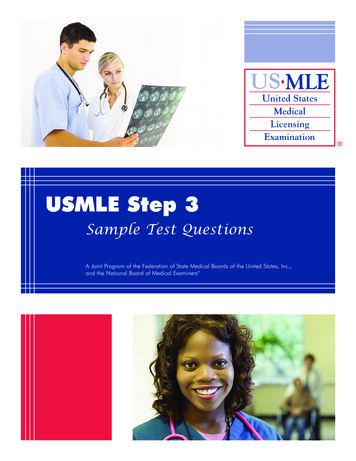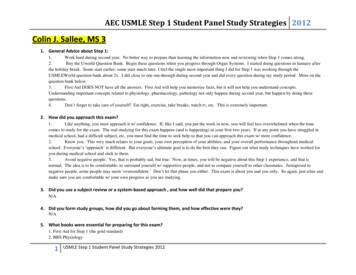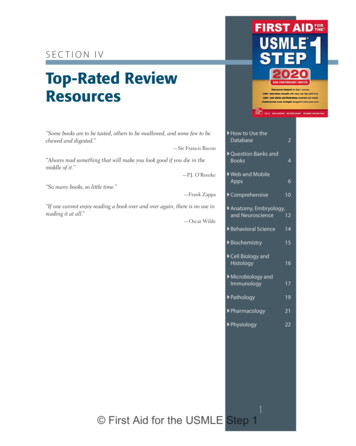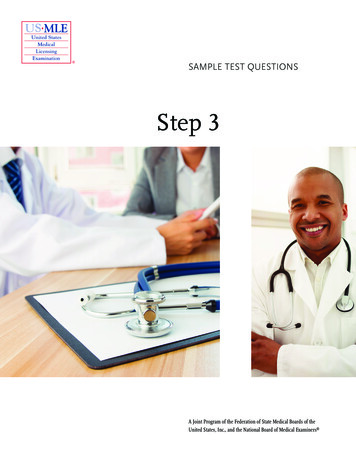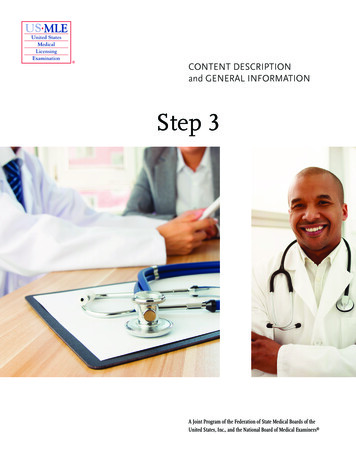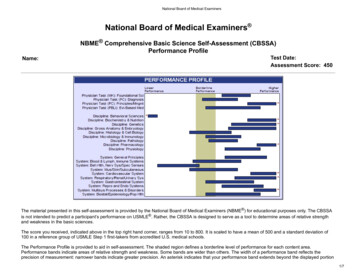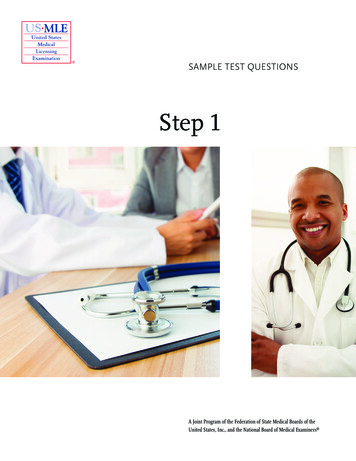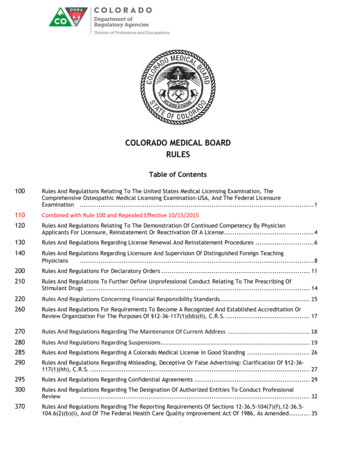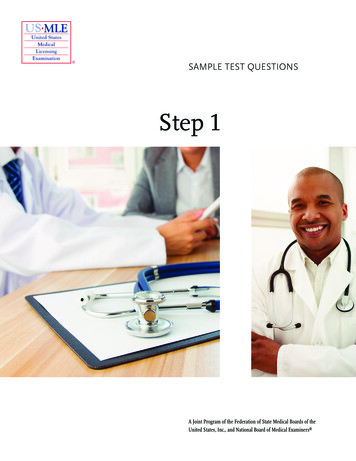
Transcription
USMLE Step 1Sample Test QuestionsA Joint Program of the Federation of State Medical Boards of the United States, Inc.,and the National Board of Medical Examiners
This booklet updated April 2014.Copyright 2014 by the Federation of State Medical Boards of the United States, Inc. (FSMB), and theNational Board of Medical Examiners (NBME ). All rights reserved. Printed in the United States ofAmerica. The United States Medical Licensing Examination (USMLE ) is a joint program of the FSMB andthe NBME.1
CONTENTSUSMLE Step 1 Test Question Formats . 3Introduction to USMLE Step 1 Sample Test Questions 4Normal Laboratory Values . 5USMLE Step 1 Sample Test Questions . 7Answer Form for USMLE Step 1 Sample Test Questions . 42Answer Key for USMLE Step 1 Sample Test Questions 432
USMLE Step 1 Test Question FormatsStrategiesThe following are strategies for answering one-best-answer items: Read each question carefully. It is important to understand what is being asked. Try to generate an answer and then look for it in the option list. Alternatively, read each option carefully, eliminating those that are clearly incorrect. Of the remaining options, select the one that is most correct. If unsure about an answer, it is better to guess since unanswered questions are automatically counted as wronganswers.Single-Item QuestionsA single patient-centered vignette is associated with one question followed by four or more response options. Theresponse options are lettered (ie, A, B, C, D, E). A portion of the questions involves interpretation of graphic or pictorialmaterials. You are required to select the best answer to the question. Other options may be partially correct, but there isonly ONE BEST answer. This is the traditional, most frequently used multiple-choice question format on the examination.Example ItemA 32-year-old woman with type 1 diabetes mellitus has had progressive renal failure over the past 2 years. She has not yetstarted dialysis. Examination shows no abnormalities. Her hemoglobin concentration is 9 g/dL, hematocrit is 28%, andmean corpuscular volume is 94 μm3. A blood smear shows normochromic, normocytic cells. Which of the following is themost likely cause?(A)(B)(C)(D)(E)(F)Acute blood lossChronic lymphocytic leukemiaErythrocyte enzyme deficiencyErythropoietin deficiencyImmunohemolysisMicroangiopathic hemolysis(G)(H)(I)(J)Polycythemia veraSickle cell diseaseSideroblastic anemiaβ-Thalassemia trait(Answer: D)Sequential Item SetsA single patient-centered vignette may be associated with two or three consecutive questions about the informationpresented. Each question is associated with the initial patient vignette but is testing a different point. You are required toselect the ONE BEST answer to each question. Questions are designed to be answered in sequential order. You must click“Proceed to Next Item” to view the next item in the set; once you click on this button, you will not be able to add orchange an answer to the displayed (previous) item.NOTE: Some item types that appear on the Step 1 examination are NOT depicted in the sample items provided in thisbooklet: sequential item sets and items with multimedia features (such as audio). In addition, when additional itemformats are added to the exam, notice will be provided at the USMLE Web site: www.usmle.org. You must monitor theWeb site to stay informed about the types of items that occur in the exam, and must practice with the downloadablesample test items available on the USMLE Web site to be fully prepared for the examination.3
Introduction to USMLE Step 1 Sample Test QuestionsThe following pages include 138 sample test questions. Most of these questions are the same as those you install on yourcomputer from the USMLE Web site. Please note that reviewing the sample questions as they appear on pages 7-41 is nota substitute for practicing with the test software. You should download and run the Step 1 tutorial and practice test itemsthat are provided on the USMLE website well before your test date. The sample materials available at the USMLE Website include additional items and item formats that do not appear in this booklet, such as items with associated audio orvideo findings and sequential item sets. You should become familiar with all item formats that will be used in the actualexamination.Although the sample questions exemplify content on the examination, they may not reflect the content coverage onindividual examinations. In the actual examination, questions will be presented in random order; they will not be groupedaccording to specific content. The questions will be presented one at a time in a format designed for easy on-screenreading, including use of exhibit buttons for the Normal Laboratory Values Table (included here on pages 5 6) and somepictorials. Photographs, charts, and x-rays in this booklet are not of the same quality as the pictorials used in the actualexamination. In addition, you will be able to adjust the brightness and contrast of pictorials on the computer screen.To take the following sample test questions as they would be timed in the actual examination, you should allow amaximum of one hour for each 46-item block, for a total of three hours. Please be aware that most examinees perceive thetime pressure to be greater during an actual examination. An answer form for recording answers is provided on page 42.An answer key is provided on page 43. In the actual examination, answers will be selected on the screen; no answer formwill be provided.4
LABORATORY VALUES* Included in the Biochemical Profile (SMA-12)REFERENCE RANGESI REFERENCE INTERVALSBLOOD, PLASMA, SERUM* Alanine aminotransferase (ALT), serum . 8-20 U/L . 8-20 U/LAmylase, serum . 25-125 U/L . 25-125 U/L* Aspartate aminotransferase (AST), serum . 8-20 U/L . 8-20 U/LBilirubin, serum (adult) Total // Direct . 0.1-1.0 mg/dL // 0.0-0.3 mg/dL . 2-17 μmol/L // 0-5 μmol/L* Calcium, serum (Ca2 ) .8.4-10.2 mg/dL . 2.1-2.8 mmol/L* Cholesterol, serum . Rec: 200 mg/dL . 5.2 mmol/LCortisol, serum . 0800 h: 5-23 μg/dL // 1600 h: 3-15 μg/dL 138-635 nmol/L // 82-413 nmol/L2000 h: 50% of 0800 h . Fraction of 0800 h: 0.50Creatine kinase, serum .Male: 25-90 U/L . 25-90 U/LFemale: 10-70 U/L . 10-70 U/L* Creatinine, serum . 0.6-1.2 mg/dL . 53-106 μmol/LElectrolytes, serumSodium (Na ) . 136-145 mEq/L . 136-145 mmol/L* Potassium (K ) . 3.5-5.0 mEq/L . 3.5-5.0 mmol/LChloride (Cl–) . 95-105 mEq/L . 95-105 mmol/LBicarbonate (HCO3–) . 22-28 mEq/L . 22-28 mmol/LMagnesium (Mg2 ) . 1.5-2.0 mEq/L . 0.75-1.0 mmol/LEstriol, total, serum (in pregnancy)24-28 wks // 32-36 wks .30-170 ng/mL // 60-280 ng/mL . 104-590 nmol/L // 208-970 nmol/L28-32 wks // 36-40 wks .40-220 ng/mL // 80-350 ng/mL . 140-760 nmol/L // 280-1210 nmol/LFerritin, serum . Male: 15-200 ng/mL . 15-200 μg/LFemale: 12-150 ng/mL . 12-150 μg/LFollicle-stimulating hormone, serum/plasma .Male: 4-25 mIU/mL . 4-25 U/LFemale: premenopause 4-30 mIU/mL . 4-30 U/Lmidcycle peak 10-90 mIU/mL . 10-90 U/Lpostmenopause 40-250 mIU/mL . 40-250 U/LGases, arterial blood (room air)pH .7.35-7.45 . [H ] 36-44 nmol/LPCO2 .33-45 mm Hg . 4.4-5.9 kPaPO2 .75-105 mm Hg . 10.0-14.0 kPa* Glucose, serum . Fasting: 70-110 mg/dL . 3.8-6.1 mmol/L2-h postprandial: 120 mg/dL . 6.6 mmol/LGrowth hormone - arginine stimulation . Fasting: 5 ng/mL . 5 μg/Lprovocative stimuli: 7 ng/mL . 7 μg/LImmunoglobulins, serumIgA .76-390 mg/dL . 0.76-3.90 g/LIgE .0-380 IU/mL . 0-380 kIU/LIgG .650-1500 mg/dL . 6.5-15 g/LIgM .40-345 mg/dL . 0.4-3.45 g/LIron .50-170 μg/dL . 9-30 μmol/LLactate dehydrogenase, serum . 45-90 U/L . 45-90 U/LLuteinizing hormone, serum/plasma . Male: 6-23 mIU/mL . 6-23 U/LFemale: follicular phase 5-30 mIU/mL . 5-30 U/Lmidcycle 75-150 mIU/mL . 75-150 U/Lpostmenopause 30-200 mIU/mL . 30-200 U/LOsmolality, serum . 275-295 mOsmol/kg H2O . 275-295 mOsmol/kg H2OParathyroid hormone, serum, N-terminal . 230-630 pg/mL . 230-630 ng/L* Phosphatase (alkaline), serum (p-NPP at 30 C) .20-70 U/L . 20-70 U/L* Phosphorus (inorganic), serum . 3.0-4.5 mg/dL . 1.0-1.5 mmol/LProlactin, serum (hPRL) . 20 ng/mL . 20 μg/L* Proteins, serumTotal (recumbent) . 6.0-7.8 g/dL . 60-78 g/LAlbumin . 3.5-5.5 g/dL . 35-55 g/LGlobulin . 2.3-3.5 g/dL . 23-35 g/LThyroid-stimulating hormone, serum or plasma .0.5-5.0 μU/mL . 0.5-5.0 mU/LThyroidal iodine (123I) uptake .8%-30% of administered dose/24 h . 0.08-0.30/24 hThyroxine (T4), serum . 5-12 μg/dL . 64-155 nmol/LTriglycerides, serum. 35-160 mg/dL . 0.4-1.81 mmol/LTriiodothyronine (T3), serum (RIA) . 115-190 ng/dL . 1.8-2.9 nmol/LTriiodothyronine (T3) resin uptake . 25%-35% . 0.25-0.35* Urea nitrogen, serum . 7-18 mg/dL . 1.2-3.0 mmol/L* Uric acid, serum . 3.0-8.2 mg/dL . 0.18-0.48 mmol/L5
LABORATORY VALUES (continued from previous page)REFERENCE RANGESI REFERENCE INTERVALSBODY MASS INDEX (BMI)Body mass index . Adult: 19-25 kg/m2CEREBROSPINAL FLUIDCell count . 0-5/mm3 . 0-5 x 106/LChloride . 118-132 mEq/L . 118-132 mmol/LGamma globulin . 3%-12% total proteins . 0.03-0.12Glucose . 40-70 mg/dL . 2.2-3.9 mmol/LPressure . 70-180 mm H2O . 70-180 mm H2OProteins, total . 40 mg/dL . 0.40 g/LHEMATOLOGICBleeding time (template) . 2-7 minutes . 2-7 minutesErythrocyte count . Male: 4.3-5.9 million/mm3 . 4.3-5.9 x 1012/LFemale: 3.5-5.5 million/mm3 . 3.5-5.5 x 1012/LErythrocyte sedimentation rate (Westergren). Male: 0-15 mm/h . 0-15 mm/hFemale: 0-20 mm/h . 0-20 mm/hHematocrit . Male: 41%-53% . 0.41-0.53Female: 36%-46% . 0.36-0.46Hemoglobin A1c . 6% . 0.06Hemoglobin, blood. Male: 13.5-17.5 g/dL . 2.09-2.71 mmol/LFemale: 12.0-16.0 g/dL . 1.86-2.48 mmol/LHemoglobin, plasma . 1-4 mg/dL . 0.16-0.62 mmol/LLeukocyte count and differentialLeukocyte count . 4500-11,000/mm3 . 4.5-11.0 x 109/LSegmented neutrophils . 54%-62% . 0.54-0.62Bands. 3%-5% . 0.03-0.05Eosinophils . 1%-3% . 0.01-0.03Basophils . 0%-0.75% . 0-0.0075Lymphocytes . 25%-33% . 0.25-0.33Monocytes . 3%-7% . 0.03-0.07Mean corpuscular hemoglobin . 25.4-34.6 pg/cell . 0.39-0.54 fmol/cellMean corpuscular hemoglobin concentration . 31%-36% Hb/cell . 4.81-5.58 mmol Hb/LMean corpuscular volume . 80-100 μm3 . 80-100 fLPartial thromboplastin time (activated) . 25-40 seconds . 25-40 secondsPlatelet count . 150,000-400,000/mm3 . 150-400 x 109/LProthrombin time . 11-15 seconds . 11-15 secondsReticulocyte count. 0.5%-1.5% . 0.005-0.015Thrombin time . 2 seconds deviation from control . 2 seconds deviation from controlVolumePlasma . Male: 25-43 mL/kg. 0.025-0.043 L/kgFemale: 28-45 mL/kg . 0.028-0.045 L/kgRed cell . Male: 20-36 mL/kg . 0.020-0.036 L/kgFemale: 19-31 mL/kg . 0.019-0.031 L/kgSWEATChloride. 0-35 mmol/L . 0-35 mmol/LURINECalcium . 100-300 mg/24 h . 2.5-7.5 mmol/24 hChloride. Varies with intake . Varies with intakeCreatinine clearance . Male: 97-137 mL/minFemale: 88-128 mL/minEstriol, total (in pregnancy)30 wks . 6-18 mg/24 h . 21-62 μmol/24 h35 wks . 9-28 mg/24 h . 31-97 μmol/24 h40 wks . 13-42 mg/24 h . 45-146 μmol/24 h17-Hydroxycorticosteroids . Male: 3.0-10.0 mg/24 h . 8.2-27.6 μmol/24 hFemale: 2.0-8.0 mg/24 h. 5.5-22.0 μmol/24 h17-Ketosteroids, total . Male: 8-20 mg/24 h . 28-70 μmol/24 hFemale: 6-15 mg/24 h. 21-52 μmol/24 hOsmolality . 50-1400 mOsmol/kg H2OOxalate . 8-40 μg/mL . 90-445 μmol/LPotassium . Varies with diet . Varies with dietProteins, total . 150 mg/24 h . 0.15 g/24 hSodium . Varies with diet . Varies with dietUric acid . Varies with diet . Varies with diet6
USMLE STEP1 SAMPLE TEST QUESTIONSBLOCK 1, ITEMS 1-461.A 25-year-old woman is brought to theemergency department 1 hour after she fainted.She has had mild intermittent vaginal bleeding,sometimes associated with lower abdominalpain, during the past 3 days. She has had severecramping pain in the right lower abdomen for12 hours. She has not had a menstrual period for3 months; previously, menses occurred at regular28-day intervals. Abdominal examination showsmild tenderness to palpation in the right lowerquadrant. Bimanual pelvic examination shows atender walnut-sized mass in the rightparametrium. Which of the following is the mostlikely diagnosis?(A)(B)(C)(D)(E)(F)3.(A) Adenine phosphoribosyltransferasedeficiency(B) iency(C) Increased cellular turnover of nucleicacids(D) Increased conversion of hypoxanthineto inosine monophosphate(E) Phosphoribosylpyrophosphatesynthetase deficiencyAppendicitisCancer of the ovaryEctopic pregnancyEndometriosisOvarian cystPlacenta previa4.2.A 12-year-old girl with a 1-year history ofsystemic lupus erythematosus is brought to thephysician for a routine follow-up examination.During the past year she has done well with theexception of occasional mild frontal headaches,fatigue, and arthralgias; the results of regularlaboratory evaluations have been stable. She hasmissed 20 days of school in the past 4 months.Her parents express concern that sending her toschool might cause her to be exposed to childrenwith contagious diseases that might exacerbatetheir daughter's condition. The girl tells thephysician that she misses seeing her manyfriends at school. Passive motion of the elbows,wrists, and knees produces mild discomfort.Physical examination shows no otherabnormalities. Which of the following is themost likely cause of this patient's excessiveschool absences?(A)(B)(C)(D)(E)A 4-year-old boy has delayed motordevelopment and choreoathetosis. He had normaldevelopment at birth. He chews his fingers andlips, which has resulted in tissue loss. He hasarthritis. Serum and urine uric acidconcentrations are increased. Which of thefollowing abnormalities is the most likely causeof these findings?A 42-year-old woman comes to the physician fora routine examination. She says that she has feltwell except for occasional episodes ofconstipation, abdominal discomfort, and mildfatigue. She was treated for a renal calculus 10years ago and was told she had a "lazygallbladder." Her pulse is 82/min, and bloodpressure is 150/80 mm Hg. Physical examinationshows no other abnormalities. Laboratory studiesshow:Erythrocyte countSerumK Cl–Ca2 PhosphorusAlkaline phosphatase3 million/mm34.5 mEq/L107 mEq/L12 mg/dL2.2 mg/dL95 U/LThe most likely cause of this patient's conditionis a small, well-defined nodule in which of thefollowing locations?Lupus arthritisLupus cerebritisMalingeringSchool phobiaVulnerable child syndrome(A)(B)(C)(D)(E)(F)7Adrenal glandAnterior pituitary glandGallbladderKidneyParathyroid glandThymus
7.5.6.(A)(B)(C)(D)(E)A 4-year-old girl has the sudden onset ofabdominal pain and vomiting. She has a mass inthe right lower quadrant and hyperactive bowelsounds. A segment of resected bowel is shown inthe photograph. Which of the following is themost likely tionMeckel diverticulumNecrotizing enterocolitisStrangulated herniaA 12-year-old girl with sickle cell disease haspain in her right arm. An x-ray of the right upperextremity shows bony lesions consistent withosteomyelitis. Which of the following is the mostlikely causal organism?(A)(B)(C)(D)(E)(F)(G)A 3-year-old boy is brought to the physicianbecause of fever, headache, and sores on hisback and left shoulder for 1 day. His temperatureis 37.8 C (100 F). Physical examination showsvesicles over the back and left shoulder as in thephotograph shown. Treatment with aspirin isCONTRAINDICATED in this patient because ofan epidemiologic association with a syndromethat includes which of the following adverseeffects?BronchoconstrictionDisseminated intravascular coagulationGastric irritationHepatomegalyImmunosuppressionA 62-year-old woman comes to the physicianbecause of low back pain for 1 week. Menopauseoccurred 10 years ago. Physical examinationshows localized tenderness over the lumbar spineafter movement. X-rays of the spine show acompression fracture of L1-2. A DEXA scanshows decreased bone mineral density. Serumcalcium and phosphorus concentrations andserum alkaline phosphatase activity are withinthe reference ranges. A bisphosphonate drug isprescribed. The expected beneficial effect of thisdrug is most likely due to which of the followingactions?(A) Decreased insulin-like growth factor-1concentration(B) Decreased osteoclast activity(C) Decreased osteoprotegerin production(D) Increased 1,25dihydroxycholecalciferolconcentration(E) Increased osteoblast activity(F) Increased receptor activator of NF-κBligand (RANKL) productionClostridium septicumEnterococcus faecalisListeria monocytogenesProteus mirabilisPseudomonas aeruginosaSalmonella enteritidisSerratia marcescens8
9.Hospital discharge of a 75-year-old man is delayed due to unavailability of a bed in a nursing home. He is bedriddenand unable to attend to his personal needs. During a 3-day period, his pulse increases from 82/min to 125/min, andblood pressure decreases from 124/72 mm Hg to 100/55 mm Hg. Laboratory values include:HemoglobinSerumUrea nitrogenGlucoseNa CreatinineDay 116.4 g/dLDay 318.4 g/dL18 mg/dL100 mg/dL135 mEq/L1.1 mg/dL56 mg/dL89 mg/dL151 mEq/L1.2 mg/dLWhich of the following is the most likely diagnosis?(A)(B)(C)(D)(E)10.Acute renal failureDehydrationDiabetic ketoacidosisGastrointestinal hemorrhageSyndrome of inappropriate ADH (vasopressin)A 76-year-old man with a history of prostatichypertrophy has the recent onset of increaseddifficulty urinating. Symptoms began shortlyafter he started taking a nasal decongestant orallyfor cold symptoms. Which of the following typesof receptors is most likely to be involved in theseadverse effects?12.α1-Adrenergicβ2-AdrenergicGanglionic nicotinicNicotinic receptor at the neuromuscularjunction(E) Serotoninergic(A)(B)(C)(D)11.(A) Significant findings can be reportedwith greater confidence(B) The study will have more power(C) There is a decreased likelihood of aType II error(D) There is an increased likelihood ofstatistically significant findings(E) There is an increased likelihood of aType I errorA 15-year-old girl is brought to the physicianbecause of a 3-week history of excessive thirstand voiding excessive amounts of urine. Sheshows no signs of kidney damage, and she is nottaking any medications. Physical examinationshows no abnormalities. She undergoes an 8hour water deprivation test. She is also given5 units of ADH (vasopressin), subcutaneously.Under both conditions, she continues to producelarge volumes of dilute urine. Her symptoms aremost likely due to a relative lack of which of thefollowing proteins from the apical membranes ofcollecting duct epithelial cells?(A)(B)(C)(D)(E)A placebo-controlled clinical trial is conductedto assess whether a new antihypertensive drug ismore effective than standard therapy. A total of5000 patients with essential hypertension areenrolled and randomly assigned to one of twogroups: 2500 patients receive the new drug and2500 patients receive placebo. If the alpha is setat 0.01 instead of 0.05, which of the following isthe most likely result?13.AquaporinEpithelial Na channelNa –K ATPaseNa –K –2Cl cotransporterUrea transporterA sexually active 23-year-old man with multiplesex partners has dysuria and a yellow urethralexudate. Gram stain of the exudate showsnumerous neutrophils, many that containintracellular gram-negative diplococci. He hashad three similar episodes of urethritis over thepast 2 years. Which of the following propertiesof the infecting organism best explains thereinfection?(A)(B)(C)(D)(E)9Antigenic variationCatalaseInhibition of B-lymphocyte functionInhibition of T-lymphocyte functionPolysaccharide capsule
14.A 68-year-old woman has the sudden onset of weakness in her right arm and leg. She can speak, but her words arenot enunciated clearly. Neurologic examination 6 weeks later shows an extensor plantar reflex on the right. Whenshe is asked to protrude her tongue, it deviates to the left, and the muscle in the left side of the tongue showsconsiderable atrophy. Which of the following labeled areas in the transverse sections of the brain stem is most likelydamaged?15.A 33-year-old woman comes to the physicianbecause of a 2-day history of mild nausea,increased urinary urgency and frequency, andconstipation. She also has had a 4.5-kg (10-lb)weight loss during the past 2 weeks and a 3week history of vaginal bleeding. Pelvicexamination shows a nodular cervix with anirregular, friable posterior lip, and a rock-hard,irregular, immobile pelvic mass that extendsacross the pelvis. Examination of biopsyspecimens from the cervix and anterior wall ofthe vagina show well-differentiated keratinizingsquamous cell carcinoma. Which of thefollowing best describes the pathogenesis of thispatient's disease?16.A 22-year-old man develops delusions, flatteningof affect, catatonic behavior, hallucinations, andaphasia. Which of the following symptomswould be more likely to improve if this patientwere treated with clozapine rather than withhaloperidol?(A)(B)(C)(D)(E)17.(A) Inactivation of cellular p53(B) Insertion of viral promotors adjacent tocellular growth factor genes(C) Specialized transduction(D) Transactivation of cellular growthfactor genes by TAX(E) Translocation of CMYC to an Ig genepromoterAfter infection with measles virus, a
Introduction to USMLE Step 1 Sample Test Questions The following pages include 138 sample test questions. Most of these questions are the same as those you install on your computer from the USMLE Web site. Please note that reviewing the sample questions as they appear on pages 7-41 is not a substitute for practicing with the test software.


